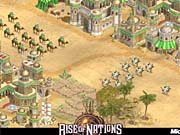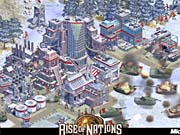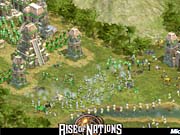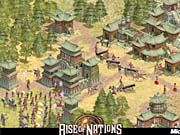Rise of Nations Q&A
Brian Reynolds tells us about his upcoming historical RTS, which is in now beta and is being polished for release.
When Brian Reynolds, the designer behind Alpha Centauri and Civilization II, founded Big Huge Games in 2000, he set out to create a real-time strategy game that combined the epic scope of Firaxis' acclaimed turn-based strategy games with the fast pace and excitement of real-time gameplay. That project, Rise of Nations, has come a long way since then, and we recently had a chance to speak with Brian Reynolds about the final stages of the game's development and what it has to offer that's unique among real-time strategy games.
Also, starting today, 500 lucky GameSpot Complete members will be selected to participate in the beta test and will receive a CD so they can start playing Rise of Nations immediately. If you're a member, you can sign up for the beta
GameSpot: Thanks for taking the time for this interview. Could you give us an update on what aspects of Rise of Nations' development the team is working on at this point?

Brian Reynolds: Right now we're in "final polish" mode--all that's left to do is fix all the bugs, be sure that the performance is good on all the systems we run on, and finish up any final gameplay balancing that we think is necessary. It's really the most fun part of the project, despite all the extra hours, since most of the time we're playing the game to help find the remaining issues.
GS: Looking back, what would you say has been the most challenging aspect of Rise of Nations' development? Balancing the different nations? Making the game accessible for new players?
BR: I think the most difficult work was toward the beginning, where we had a lot of different ideas about how to bring new concepts into real-time strategy and we had to figure out which ones would work and which ones wouldn't. For example, we thought national borders would be an interesting idea, but we didn't know if it would work in an RTS or not. We had to try them out, and then we had to figure out what set of rules worked best with them and made them most interesting.
GS: On a related note, Rise of Nations really does seem to be intended to appeal to a wide variety of potential players--die-hard real-time strategy fans, turn-based strategy experts, and even beginners who don't always have a lot of time on their hands. Would you say that the game might be more attractive to a certain audience than another?
BR: One of the things we've always tried to do in our games is provide players with a ton of options, so each person can customize the game to play the way he or she wants to. In Rise of Nations, we have all kinds of game modes, optional rules changes, player preference options, and map types to satisfy just about anyone who likes strategy games. Do you prefer a long, drawn-out game with a strong defensive tilt? Set "no rush" rules, where attacking is not permitted in the early stages of the game, and then modify the costs of technologies to be expensive so you spend more time in each age. Would you rather have an all-out slugfest? Increase the speed of resource collection and begin in the Industrial Age so you can immediately begin with airplanes and tanks.
GS: When we last spoke, you used the phrase "world history over lunch" to describe Rise of Nations' multiplayer games, meaning that multiplayer games could be started and finished within 30 minutes to an hour. Could you explain how Big Huge Games ended up paring down such a seemingly complex game to fit within this time frame?

BR: A big focus of the development has been to get rid of micromanagement wherever it rears its ugly head. Your citizens find ways to make themselves useful instead of standing around after completing a building. Units going across the ocean automatically create their own transports instead of having to be manually fumbled onto ships. This way, the focus of the game is on making the big decisions--when to expand your national borders, where to mass your troops, and what wonders of the world you should build to complement your strategy. Since you are usually only looking at the big picture, the game can easily be played in under an hour.
We've also carefully paced the game so that in your standard 30-to-60-minute multiplayer game you get to travel all the way through human history, from ancient times to the information age. All RTS games feature "upgrading your units" as you go--we just offer more dramatic upgrades (such as retraining your javelineers with muskets) that often change the game tactics significantly. So the flavor of the game changes as you go from early times to later times, which we think makes it that much more exciting.
Conquer the World
GS: In January,

BR: We made the differences in the nation powers much more dramatic. Some nations have very strong defenses, some nations have very strong offenses, and some nations have very strong economies. For example, the Chinese can build any economic unit (merchant, caravan, citizen, and so on) instantly with no production delay. On the other hand, the Aztecs gain resources whenever their troops kill an enemy unit.
GS: Could you share your thoughts on the conquer the world single-player campaign? How do you think it compares with the traditional single-player campaign game of something like Civilization II or Alpha Centauri?
BR: Conquer the world shares some of the open-ended gameplay and thoughtful strategizing of something like Civ II or Alpha Centauri, and we certainly think it will appeal to fans of those products. However, our main goal with conquer the world is to take a fresh look at the single-player campaigns usually found in real-time strategy games. Traditionally, RTS campaigns involve linear story lines with preset goals and strategies. When these are done well, they can certainly be fun, but the replayability is limited and they rely on scripted narratives. Conquer the world puts players in charge of creating the story line out of their decisions, and the resulting victories and defeats. No two games of conquer the world play out the same way, and all 18 nations have a distinct flavor based on their starting setups. It's a much more open-ended kind of game than a traditional RTS campaign, and we certainly prefer this approach.
GS: It seems safe to say that Rise of Nations is an unorthodox real-time strategy game. Looking back, what would you say is its most distinctive feature? Do you have a personal favorite?
BR: My personal favorite is probably the national borders, for several reasons. First of all, it solves several problems that used to annoy me whenever I played RTS games, such as enemies constructing buildings in the middle of my town. It also visually makes the nations look more like nations, not just through the drawing of boundary lines, but also by encouraging players to spread out their political centers to control the territory (and therefore the resources) they think they need. It also fits together very well with other game ideas (such as the idea of multiple cities) and provides for a lot of very interesting and different strategies, such as "border pushing."
GS: Do you enjoy developing games that are based on historical material, rather than sci-fi or fantasy?
BR: I do enjoy history games quite a bit, both as a player and as a designer. One nice thing about developing history games is that most players know at least something about history--you don't have to explain to them how a bow and arrow works, for instance. In a science fiction or fantasy game, you often have to do a lot more explaining. With a history game, you can start with the historical setting and build on that.
GS: We have to ask--after the game is finished and ships to stores, what's next for Big Huge Games? Any plans for a follow-up to Rise of Nations, or perhaps a completely new project?
BR: Right now we're very focused on putting all the final touches on Rise of Nations, so we haven't done a lot of planning on the next project yet. That's not to say that the subject hasn't come up occasionally during lunch outings or anything--just that nothing is definite yet.
GS: Finally, is there anything else you'd like to add about Rise of Nations?

BR: I'm really happy with the way the game has turned out. I think we've accomplished the goal we set for ourselves of making an historical RTS that breaks with much of the "classic RTS" formula to create novel and interesting gameplay, but keeps the fast-paced excitement that players like.
One last thing: Rise of Nations will be available in the US on May 20.
GS: Thanks for your time, Brian.
Got a news tip or want to contact us directly? Email news@gamespot.com
Join the conversation